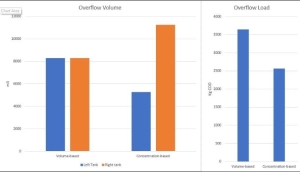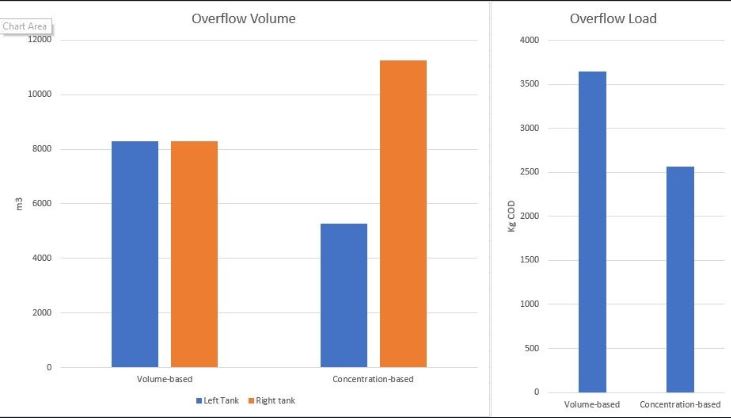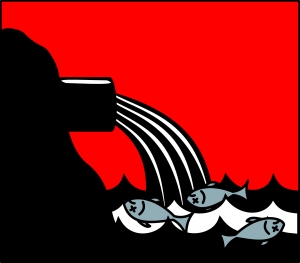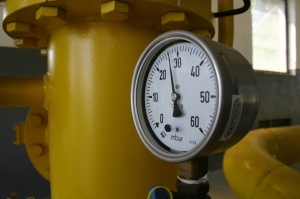Revolutionizing Sewage Overflow Control with Load-Based Optimization
Water management is an ever-evolving field and RTC4Water is at the forefront of the latest developments.
We are thrilled to announce that we have made significant progress in optimizing sewage overflows during rain events with our new product, LINKWATER.
This innovative technology addresses the limitations of the current state-of-the-art VOLUME-based methodology by introducing a load-based system that reduces the flow to the river during a rain event. Our team has successfully conducted a proof of concept test for the load-based overflow optimization and the results are impressive. The new system did 29.7% better in reducing the flow in the left tank that had a lower concentration, compared to the old volume-based system.
This is a major milestone in our mission to provide innovative solutions that benefit our clients and the environment. Our dedicated team, led by PhD student Rodrigo Gesser, has worked tirelessly to bring this product to life.
We extend our gratitude to our funding partners, the Luxembourg ministries of Economy and Finance, for their support.
At RTC4Water, we are proud to be leading the way in revolutionizing sewage overflow control.
Stay tuned for more exciting updates from our team as we continue to push the boundaries of water management.
RTC4Water Partners with Rittmeyer AG to Reduce the Impact of Wastewater Overflows in Switzerland
RTC4Water and Rittmeyer AG have signed an agreement to offer RTC4Water’s Global Predictive Controller® software to Swiss sewer network operators. In Switzerland, approximately 3 - 4% of untreated wastewater overflows into lakes, streams or rivers during periods of rain. This overflow can include high concentrations of problematic substances such as pesticides, biocides and pharmaceuticals. To reduce these overflows as much as possible, RTC4Water has developed a fully autonomous, predictive software solution that optimizes the control of overflow basins typically found in combined sewer networks.
Rittmeyer AG, a subsidiary of the BRUGG Group, develops and delivers custom measurement and control technology solutions for energy and water suppliers, hydropower plants and wastewater treatment plants. Already a leader in the field, Rittmeyer AG will now be able to offer its Swiss clients one of the most advanced network optimization tools currently on the market. Dr. David Dürrenmatt, Head of Process and Environmental Technology at Rittmeyer, explains; “With RTC4Water we have found the right partner to offer our customers, and the entire Swiss wastewater industry, a clever solution designed to help them efficiently manage the basins in their sewage networks while also taking into account pollutant loads. In this way, mixed sewer water discharges into receiving waters will be sustainably and economically reduced.”
For RTC4Water, this partnership will provide the company with an invaluable opportunity to improve its wastewater expertise and further advance the technical capabilities of the software. Dr. Georges Schutz, Managing Director of RTC4Water, expressed his enthusiasm for the partnership in the following way: “With Rittmeyer AG, we have a partner at our side who is well established in the Swiss wastewater treatment market, who regularly inspires their customers with innovative solutions, and who naturally brings a high level of expertise to the table. For us this is an important step forward. For many countries, including Switzerland, it is becoming increasingly important to look for economic ways to reduce sewer overflows. RTC4Water's intelligent, predictive software helps communities of all sizes get a better grip on this problem”.
Across Europe, many wastewater administrators are now turning their attention to the tracking of these overflow events to better understand their frequency and impact on the environment. Topics such as climate change and the environmental impact of emerging pollutants such as pharmaceuticals, personal care products (PCPs), pesticides and, more recently, microplastics, will mean that all wastewater operators – in addition to the already demanding work of managing their wastewater treatment plants - will need to consider the full impact of sewage overflows more closely than before. EurEau, the European federation of national associations of water services, has an excellent paper on the topic of sewer overflows which can be found here.
Since 2012, RTC4Water pioneered the use of Real-Time Control software for the optimization of wastewater networks in Luxembourg. If your organization or municipality would like to learn more about protecting lakes and streams from sewer overflows, please do not hesitate to Cette adresse e-mail est protégée contre les robots spammeurs. Vous devez activer le JavaScript pour la visualiser..
Under Pressure Part 1: can automated network optimization help reduce pressure fluctuations?
Recently one of our close partners, the Syndicat des Eaux du Sud (SES), asked our team to assess how an automated network optimization system might reduce pressure fluctuations. While this request was a little outside of the scope of our normal activities, we readily agreed to look deeper into this question. But there was a catch: we had no pressure monitoring tools to guide our work.
Pressure fluctuations: is this a problem?
Experts estimate that Europe has a water distribution network that exceeds 3.5 million kilometers. Naturally pipeline leaks are a serious concern for the industry and, by extension, so are the effects of pressure fluctuations on a network’s longevity. Research has determined that by deploying dynamic pressure management tools, organizations can expect a 10 to 15% savings on long-term capital expenditures[1]. But with budget and staff limitations, small or medium sized distribution networks may not have the ability to deploy and monitor wireless sensors or even install pressure reduction valves. For many organizations, finding additional support to implement cost efficient tools which extend the lifespan of existing infrastructure can be a difficult.
Where to Start?
As there were no pressure monitoring tools available, our team had to rely on the modelling tools and techniques that were already being developed for the client. SES was already concerned with finding new ways to create savings and so our team was already working with them to improve network efficiency without increasing operator workload. One section of their network was chosen and, once the mapping and modeling of the system was completed, a virtual environment was developed using EPANET and our Global Predictive Controller™ to dynamically test the network’s behavior with and without automated optimization. Specifically, an examination of the pressure fluctuations at the point of entry of the tanks was used to provide an indication of the expected reduction in pressure fluctuations. It is interesting to note that SES uses advanced flow control valves on some of their inlet valves and these valves are set-up to have reduced maximum flows – one way to reduce pressure fluctuations. And as most of the receiving reservoirs in this section did not have a large difference in elevation, we knew that this test might not show extraordinary results.
Preliminary results
The Global Predicative Controller is designed to “smooth out” or homogenize the activity of all basins, pumps and valves within the network based on organizations goals such as reserved capacity levels, water quality or pumping costs. In theory, this homogenization should reduce the long-term stress on the distribution infrastructure. With only modelling data to work with, it is difficult to assign a “real world” number which quantifies these cost savings. However, our analysis did show that there would be a significant reduction in pressure fluctuations for all reservoir inlets. Below is an example from one of the reservoirs:
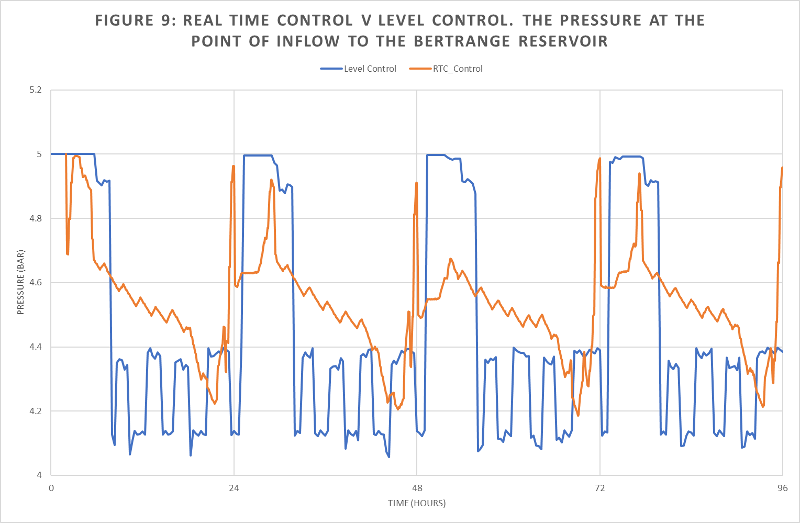
Since the difference in elevation between reservoirs for this test was not great, it cannot be said that the reduction in pressure fluctuations will have a large impact on the network’s lifespan. However, it is reasonable to accept that networks which operate under higher pressure conditions will see a significant benefit.
What can be said with some confidence is that the implementation of our system will improve the specific difficulty currently experienced here, which is that under certain conditions a reservoir may not receive a sufficient flow because other reservoirs are also filling up.
Exploring new technologies and looking for better ways to add value takes courage, and we are especially grateful to the SES team and Mr. Tom Levy for their support, not only as clients, but as experts dedicated to improving water quality. Mr. Levy was also instrumental to helping us present the technical results of this research at this year’s CEOCOR conference. Please see their website for the full abstract on this research and, as always, please contact us if you would like to know more about our products and services. We hope to repeat this analysis again using pressure data so please check out our Blog page from time to time if this topic is of interest to you.
[1] http://www.ee.co.za/article/advantages-water-pressure-management.html






